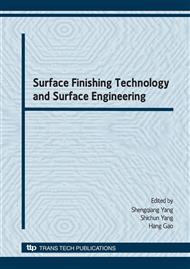p.261
p.265
p.273
p.279
p.285
p.293
p.299
p.305
p.311
The Properties and the Influence Factors of the White Layer in the Surface Grinding
Abstract:
The properties of the white layer in the surface grinding are described. The influences of heat treatment, carbon content and grinding conditions on the white layer formation are discussed. It is found that the white layer in the hardened steel is thicker and harder than that in the annealed steel, and there is not a softer transition zone in the annealed steel. Higher carbon content tends to increase white layer thickness at the larger cutting depth, while no difference is observed at the smaller cutting depth. Increased carbon content tends to increase white layer hardness. The white layer thickness increases as the cutting depth increases. The white layer thickness increases with the rise of the table speed until a certain critical speed value is reached, beyond which the white layer thickness decreases with the increase of the table speed. The white layer in the central zone of the workpiece is thicker than that in the entrance zone, but it is thinner than that in the exit zone.
Info:
Periodical:
Pages:
285-292
Citation:
Online since:
July 2008
Authors:
Keywords:
Price:
Сopyright:
© 2008 Trans Tech Publications Ltd. All Rights Reserved
Share:
Citation:


